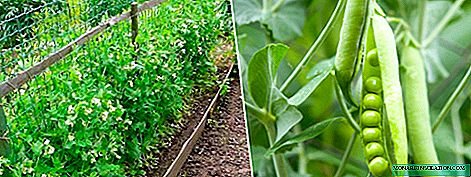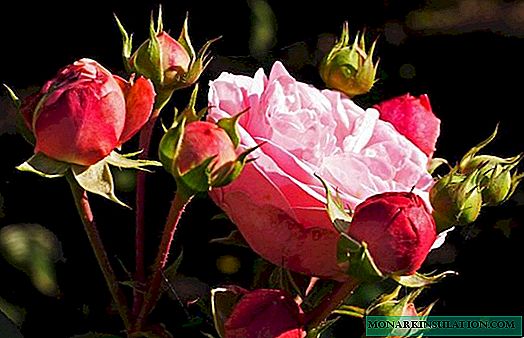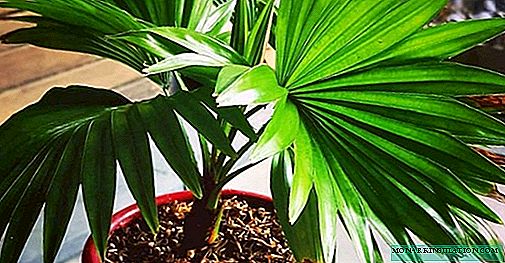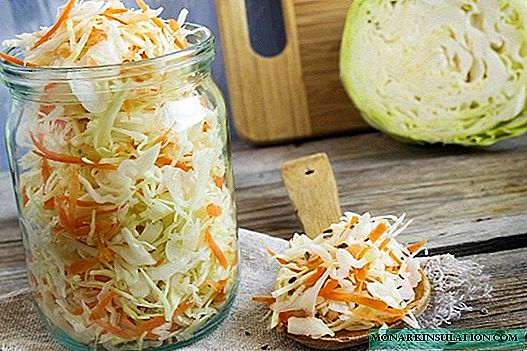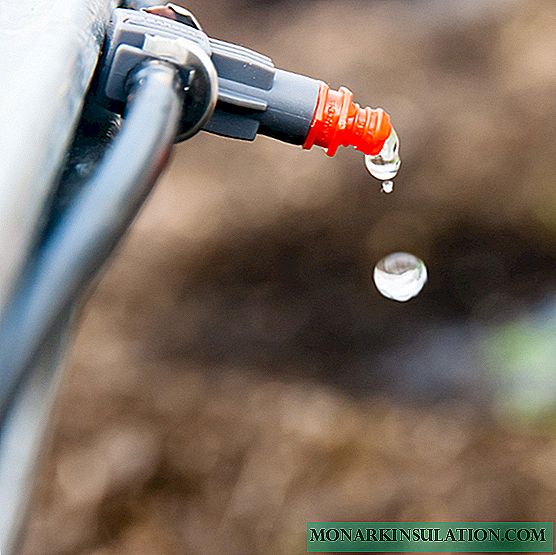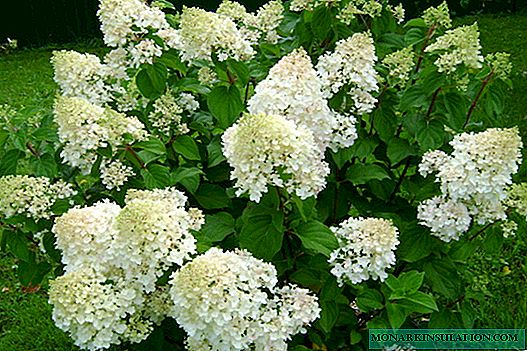
It is not easy to grow a good onion, but summer residents of almost all regions are still doing this. Most often, onions are planted with sevk: it is easier and more reliable. Features of agricultural technology of onions in the Urals are associated with harsh climatic conditions.
Varieties of onions for growing in the Urals
The climate of the Ural region is notable for a short summer. It may be warm, but comes late, and autumn comes early. This leaves an imprint on the choice of cultivated onion varieties. Early ripening varieties are best suited for the Urals, and medium-ripening varieties are planted, adapted to local conditions. True, the only medium-late variety, Mannito, included in the State Register of the Russian Federation in 2011, was bred specifically for the Ural region, and it can be grown directly from seeds, in an annual culture.
A number of varieties are recommended both for the Urals and for some other regions. One of the most popular old varieties is the early ripe onion Annual Siberian. It has a semi-sharp taste, is well stored, the bulbs are flat or rounded flat, weighing about 50 g. An older variety grown since 1943 is Bessonovsky local. This is an early ripe high-yielding onion of a sharp taste, the mass of the bulb is about 40 g, the shape is flat to rounded flat. It is used both fresh and in the canning industry; during winter storage, waste is only about 10%.
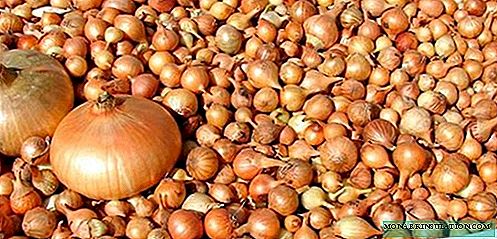
Bessonovsky local - one of the most famous varieties of onions
A relatively new variety of Boterus belongs to mid-early, transverse-elliptical bulbs grow up to 80 g, the taste is sharp. It is subject to long storage. Sputnik onion is mid-season, bulbs are flat, weighing up to 80 g, of a semi-acute taste. It is characterized by good keeping quality, stable productivity, high resistance to downy mildew.
Among varieties of foreign origin in the Urals, it is recommended, for example, to cultivate Sterling onions, although it is late-ripening, and medium-late onions Music. Varieties Wellington and Sanskin are mid-season, bulbs are round, large, reach a mass of 110 g, peninsular, suitable for winter storage.

Sterling bow suitable for winter storage
In addition to the above, for cultivation from sevka in the Urals, the following varieties are recommended:
- Handsome man;
- Black Prince;
- Yukont;
- Turbo;
- Myachkovsky 300;
- Arzamas local;
- Strigunovsky local.
Of course, not all Ural regions and territories are homogeneous in climate: the choice of varieties in the South Urals is somewhat wider, and varieties suitable, for example, for the Middle and even the Lower Volga, are also suitable there. Yes, and summer residents - people are fond of, experimenting with varieties, and plant those that are not always suitable for a particular climate.
Planting onion sets
In addition to growing onions from seed, the seedling method and direct growing from seeds are known. Seedling method is time-consuming, it is rarely practiced. The method of growing onions in an annual seed culture is very tempting, there are many varieties designed specifically for this purpose. But the method is more suitable for regions with a long summer: from onion seeds to a full onion in the Urals, the onion does not always manage to grow. Traditionally, onions are grown in the region from sevka obtained last season from seeds.
Landing time
In any region, onions can be planted early, but it is precisely commodity bulbs that grow from it, and not just a feather, and even more so that it does not go into the arrow, an too early landing is not good. Landing dates are determined by the following circumstances:
- night temperatures should not fall below +5 aboutFROM;
- the soil at a depth of 5-6 cm should warm up to 7 ... 10 aboutFROM;
- after winter, the soil should dry out a bit, not be slushy, waterlogged;
- the daylight hours should cross the line of 9-10 hours.
In most of the Ural region, such conditions are in place by mid-May. If heat is retained, the bed is temporarily covered with a dark film, trying to warm it by the deadline.
Some enthusiasts plant a small amount of sowing even before winter, but this is a risky option in the Urals. Landing should be carried out 2-3 weeks before the arrival of frost. It is important that heavy snow falls on time, wrapping the garden bed. The advantage of autumn planting is the minimum risk of damage to the culture of the onion fly.
Site selection and bed preparation
Onions normally grow only on breathable, loose soils; they can be either loamy or sandy loamy, with a neutral reaction of the medium. Acidic soils necessarily lime. Stagnation of water should be eliminated, it is better to choose a small hill. Shading of the beds should be absent: onions are grown in sunny areas. Onions react negatively even to partial shade formed by shrubs or hedges. In the Urals, the beds are raised above the surface of the earth: on light soils by 10 cm, on heavy soils a little more.

Onion beds must be well lit by the sun
It is better if cucumbers, tomatoes, potatoes, cabbage, and radishes grew in front of onions in the garden. Do not plant onions after garlic, radish, sunflower, any variety of onions. But carrots planted in the neighborhood are the best way to rid onions of many pests.
High soil fertility is the main condition for obtaining good yields. The garden is sure to be prepared in the fall, digging the soil deep with fertilizer application. On 1 m2 add at least a bucket of good humus, but not fresh manure: it will lead to abundant growth of foliage and will not let the bulbs mature. From mineral fertilizers, it is more convenient to add 60-80 g of nitrophoska per 1 m simultaneously with humus2.
If the soil is too clay, add river sand and peat.
In spring, the prepared bed is loosened with a rake, after sprinkling it with wood ash (a handful per square meter). If during the winter the soil is too compacted, re-dig it with a pitchfork: it is important that it be loose to a depth of 15 cm.
Preparation of sets
Usually summer residents do not grow sevocs on their own, but buy. If sevoc is bought in autumn, it is sorted and stored in winter in small linen bags or in boxes no more than 15 cm high. Store either at room temperature or, conversely, in the cold (about -2 aboutFROM). If sowing is stored at intermediate temperatures, it leaves much on the bed in the arrow. Periodically, the seeds are inspected, the diseased and dried onions are rejected.
Finally, the seeds are sorted out 3-4 days before planting. Sprouted bulbs are best planted separately on the greens. Sevka of the 1st class is considered to be the best: these are bulbs with a size of 15-22 mm (it is often called a sample). If the winter is stored in the cold, it is heated at 30 aboutWith at least a week. On the day before planting, semi-dry tops are removed, after which the onions are soaked in warm water. Optimum temperature 35-38 aboutC, time - 1-2 hours. Some gardeners believe that it is better to leave the onions in the water for a day.
Another method of preparation requires accuracy, but guarantees an almost complete absence of shooting. Bulbs are poured with hot water for only 2 minutes, but its temperature should be between 65-70 ° C. Then it is quickly cooled in cold water. A half-hour treatment with a 0.1% potassium permanganate solution also makes sense: this is both disinfection and micronutrient saturation.
In addition to potassium permanganate, you can hold the sevoc for 8-10 hours in a nutrient solution: 1 tablespoon of azofoska per 10 liters of water. After this treatment, it is placed in a solution of copper sulfate of the same concentration for 8-10 minutes. These measures strengthen the immune system and eliminate possible pathogens. After processing, the onions are washed with water and dried a little.

Among the preparations that are treated with sevoc before planting, there are also birch tar
Landing pattern
Traditionally, sevoc is planted in a tape way. In this case, between the rows leave about 20 cm, and between the plants in the rows the distances depend on the size of the bulbs. So, the smallest sevka is planted after 5-6 cm, the middle one, with a diameter of up to 2 cm, slightly less often, and the largest - after 8-10 cm.
Depth of landing is of great importance. Usually it is 3-4 cm. If planted deeper, the onion will grow longer, and in cold climates it can partially rot. If the planting is too small and the bulbs look out, then in hot weather they stop growing. Depth also slightly depends on the size of the seedling: a guideline - the tip of the onion’s neck should be close to the soil surface.
When marking the beds, it is worth choosing the correct direction of the grooves. In the Urals, they are oriented east-west. Furrows are made, for example, by the corner of a hoe, sand is poured on their bottom with a layer of 1 cm and dusted with ash. The bulbs are slightly pressed into the soil and covered with it, then the bed is leveled, which is convenient to do with the back of the rake. The garden bed is neatly watered from a watering can, always with a strainer. If the soil is prone to cracking, you can mulch it with a thin layer of humus.
Video: planting onion sets
Features of onion care in the Urals
Features of onion care in the Urals are the need for its cultivation in a short time and, in this regard, careful observance of all the rules for caring for this crop. It is necessary to monitor all negative changes in the weather and take timely measures to minimize their impact on plants. This applies to both possible cooling and heat in the middle of summer, which often comes to this region.
Onions especially require moisture in the first half of the season. In May and early June, in the absence of rain, at least a bucket of water per square meter of beds is weekly spent. By mid-summer, watering is reduced, but if it is hot, “dry watering” is required - shallow loosening of the soil after each watering or thorough mulching of the bed, but without falling asleep over the shoulders. Simultaneously with loosening throughout the entire growing season, weeds are carefully weeded. Watering completely stop 15-20 days before harvesting.
During the season, onions planted with sevk are fed 2-3 times. In feeding, infusions of mullein (1:10) or mowed herbs are used. A bucket of infusion is poured onto 3 m2. The first time they feed onions with a feather height of 10-12 cm, the second - after another two weeks, the third - after the onions reach the size of a walnut.

They try to feed onions with organic fertilizers
Despite the fact that onions are a cold-resistant crop, with an unexpected sharp drop in temperature in the first half of the growing season, it is worthwhile to cover the plantings with a spanbond, otherwise the risk of the onions going into the arrow increases. If a small number of plants undergo shooting, the arrows break off; perhaps from them small bulbs will also develop. With mass shooting, the situation cannot be corrected: one must look for the reasons for this so as not to repeat crop losses in the future.
Diseases and pests of onions in the Urals, protection against them
An effective measure for the prevention of onion diseases with fungal diseases is to spray plantings with 1% Bordeaux liquid at a time when the feather grows to about 15 cm. Instead of a copper-containing drug, you can also use folk remedies. So, in the Urals, it is customary to water onions with salt water (100 g of table salt per bucket of water). Although it must be admitted that salt is more likely to help from onion fly larvae than from diseases.
Fungal diseases manifest themselves in conditions of high humidity, which is not very different in the Ural region in summer. Therefore, it is not worth talking about the fact that some selected diseases of the onion are especially manifested here: onions can equally catch any of the diseases characteristic of it. Most often found:
- Fusarium (at the same time, the bottom rots, the bulb tissue dies, then the feather turns yellow);
- peronosporosis (downy mildew): signs of the disease - gray coating on the leaves;
- gray and white rot - both leaves and bulbs rot;
- mosaic - a viral disease in which the leaves become covered with a yellowish mosaic pattern, the plants soon die, cannot be treated;
- cervical rot (bulb mold, starting from the neck after harvesting).

Peronosporosis is one of the most common onion diseases
Any viral diseases are useless to treat, plants are subject to destruction. And other diseases, although they are treated, it is difficult, therefore, it is important to prevent their occurrence. In most cases, this can be achieved with preventive measures:
- correct crop rotation;
- disinfection of seeds before planting;
- an unobstructed fit;
- preventing waterlogging of the soil;
- moderate top dressing with nitrogen restriction;
- weed control, soil loosening;
- thorough cleaning in the garden after harvesting;
- drying the onion before sending it for storage;
- neat transportation of the crop to a sanitized storage facility.
If fungal diseases occur, watering and top dressing are limited, dusting the beds with ash, loosening the soil and spraying the onions with the necessary preparations. Chemicals can be used only in the first half of the growing season, so they try to get by with folk remedies. Infusions or decoctions of dandelion, marigolds, tobacco can help. With the disease of individual plants, they are pulled out, and the soil is disinfected with a 1% solution of copper sulfate. Of the "chemistry" in the summer, copper oxychloride (40 g per 10 liters of water) is effective, which is used 2 times a week. But the leaves after this can not be eaten for a month.
Among the pests most often found:
- tobacco thrips (looks like small white spots on the leaves, which merge into large conglomerates, the leaves dry out);
- onion moth (small nocturnal butterfly): harm the plants with its greenish caterpillars, about 10 mm long;
- onion fly: large, about 1 cm, gray, larvae white. It is they who quickly make their way inside the bulbs and gnaw them;
- onion mite (oval creature up to 1 mm long): harms bulbs that rot;
- onion grub (large fly, the larvae of which feed on the flesh of the bulb).
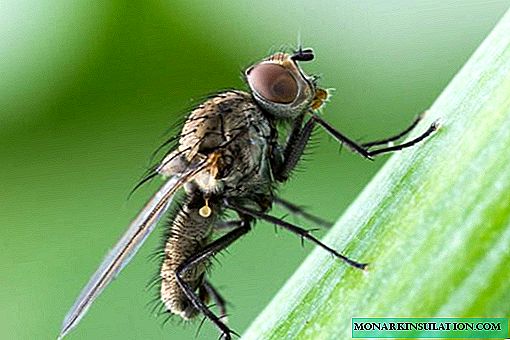
Onion fly is more common than other pests
Pest control is difficult, especially with ticks. Folk remedies can destroy pests only in small quantities, and most chemical insecticides and acaricides are dangerous to humans, therefore, in small summer cottages they are used only as a last resort. To prevent the attack of pests, take precautions:
- careful selection of seed and its preplant treatment;
- correct crop rotation;
- digging the beds after harvesting and disinfecting the soil with weak solutions of copper sulfate or potassium permanganate;
- timely weeding of beds.
Usually, in well-groomed areas, onions are not sick and are not attacked by pests.
Harvesting and storage
The bow is removed as the feather is lodged and dried. In the Urals, this occurs in August, the earliest varieties are ready for harvest at the end of July. Harvesting is carried out necessarily on a dry day, carefully digging the bulbs with a pitchfork. If the sun is shining, for several hours the onion, along with the leaves, is left to warm up and dry. Then it is folded in a thin layer under a canopy or in a well-ventilated area for 2-3 weeks for complete drying.
Usually during this time, not even completely prepared bulbs ripen, "dress". After that, the dry roots are carefully cut off, and the leaves are trimmed, leaving no more than 2-3 cm. True, many hosts store onions in braids, braiding them like a woman’s hairdo; in this case, the leaves are not cut.

After digging the bow, it is left with feathers for a long time.
If the onions are stored in bulk, this can be done in any cardboard or wooden boxes and even in nylon tights. It is important that the onion is well dried and stored in a dry, ventilated room, in the dark. Temperature does not play a big role: a good onion is stored until a new crop and in a city apartment. But periodically it is necessary to sort it out: even in an ideal-looking product, once a month you can find 1-2 rotted specimens on a bucket of onions.
Video: onion harvesting in the Urals
The main method of planting onions in the Urals is sowing. This is due to the short summer; For the same reason, growing onions in the region requires special care in performing routine procedures. It is important and to choose the right variety: it is undesirable to plant late varieties in the Urals.




